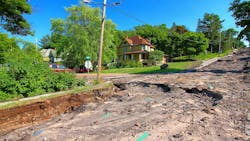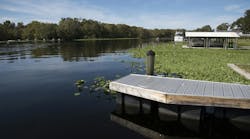Four immediate steps municipalities can take to prevent major flooding
Flooding is the most common natural disaster in the United States. in Michigan, its impact has been felt more acutely in recent years. Detroit’s 2014 500-year-flood event caused $1.8 billion in damages, followed by significant floods in 2016, 2019, and 2020. In 2021, storms brought 6 to 8 inches of rain over two days, resulting in 67,000 Federal Emergency Management Agency claims. Over the next 30 years, 21% of properties in Detroit—nearly 80,000 structures—are at risk of flooding.
The Southeast Michigan Flooding Risk Tool identifies more than 6,300 transportation-related assets at high risk, including 6,134 roads and 209 bridges – in an area home to more than 4.7 million people. The Southeast Michigan Council of Governments (SEMCOG) estimates that it would cost $1 billion each year until 2045 to sufficiently shore up stormwater draining infrastructure in just the seven counties that make up the Southeast Michigan region.
These challenges are not unique to Michigan. Across the country, extreme weather events are prompting municipalities to prioritize emergency preparedness and infrastructure improvements to safeguard residents and reduce damage. By anticipating weather-related calamities, such as flooding, and developing practical solutions for local governments to implement, it is possible to reduce flood risk and safeguard entire regions.
Lessons in resilience: Dearborn, Michigan
The City of Dearborn, Michigan, offers a compelling case study. Catastrophic floods in 2014 and 2021 overwhelmed the city’s mid-20th-century sewer system, which was built to manage far less rainfall than today’s storms deliver. The city’s sewer system had been built to accommodate 3 inches of rainfall within 24 hours, significantly more than the average monthly rainfall of 3 to 4 inches. But when individual storms dropped 5.8 inches of rain in 2014 and 7.5 inches in 2021, within one to two hours during each storm event, two-thirds of Dearborn homes had sewage in their basements.
Recognizing the urgency, Dearborn government officials took aggressive action, engaging OHM Advisors to conduct a comprehensive study, factoring in climate change, rising water levels, the impact on local infrastructure, and the resiliency of Dearborn’s existing rainwater collection system.
With 1920s and 1930s sewers in the east part of the city and 1940s and 1950s sewers to the west, the system was built on 20th-century norms. Today, large-scale storms occur every 10 years on average instead of once-in-a-lifetime. In response to these changes, the findings from this two-year study now guide the city’s short- and long-term investments in stormwater capacity and sewer upgrades to prevent flooding and eliminate sewer backups.
In nearby Ypsilanti, Michigan, a similar partnership with OHM Advisors is helping guide the development of sewage overflow solutions to ensure the system increases capacity and provides needed reliability. The city is using the study results to build a model that identifies potential failures and proposes sensible storm management strategies, incorporating feedback and ideas from community members. The majority of 2024 was focused on solutions in tandem with the public and final recommendations, which will be delivered in 2025.
Beyond expanding or upgrading facilities, it is paramount for all stakeholders to think and plan ahead. This is a collective and collaborative effort to address a societal issue.
Practical steps for immediate impact
While large-scale infrastructure projects are crucial, municipalities can take smaller, immediate steps to improve flood preparedness:
- Routine Maintenance Programs: Proactive maintenance for the region’s stormwater and combined sewer infrastructure helps ensure systems are working properly year-round. Preventative maintenance, including regular CCTV inspections, enables cities to identify and address problems before they become larger and more expensive breakdowns.
- Compliant Tracking Systems: Centralized complaint tracking systems that collect, log and analyze water- and sewage-related issues can identify patterns and prioritize solutions for vulnerable areas. This can include concerns like backups, slow drains, or even sewer odors. One key feature consists of a geographic/location tracker so that, over time, reoccurring issues in certain areas of the system can be identified and strategies developed to alleviate them.
- Post-Construction Stormwater Management: Integrating strong management programs during new and re-development ensures systems are equipped to handle increased demands and avoid strained systems. By establishing the program and blueprint right when construction ends and new residents/businesses move in, municipalities are laying the groundwork for responsible management in the future.
- Community Engagement: Educating the community on practical measures strengthens community resilience and ensures residents know what they can do to stay safe. Communicating the importance of disconnecting downspouts from the sewer system, for example, so that water discharges on the ground level away from the house or a neighbor’s home can make a discernable difference. Simple steps like these can be game changers when heavy storms overwhelm sewers. Similarly, partnerships with hospitals and schools ensure they have contingency plans for water emergencies.
Collaboration is key
Flood prevention and mitigation require collective effort. Governments, state and federal agencies, and committed stormwater management organizations nationwide are making strides to reduce risks and enhance infrastructure sustainability.
No matter where we are located, from coast to coast, inclement weather will increasingly play a part in our lives. Our preparation and capacity to respond can be the difference between an emergency and an inconvenience. Through informed planning, risk assessment, community involvement, and innovative technology, professionals can transform flooding from a disaster into a manageable challenge.
About the Author
Valerie Novaes
Valerie Novaes, P.E. serves as OHM Advisors’ Stormwater Practice Leader and is a Principal and Senior Project Manager in the firm’s Environmental & Water Resources Group. She works with clients on a wide variety of streambank and shoreline restoration designs, watershed studies, green stormwater infrastructure concepts and designs, as well as hydraulic modeling of stormwater and sanitary collection systems and stormwater policy. Valerie strives to build a reputation for OHM Advisors as experts in water quality and help the firm’s clients understand how technology and the use of data can help meet their needs more efficiently.


